If you’ve ever wanted to make your own sourdough starter, now’s the time! Since yeast is so impossible to find at the grocery store right now, I invited my friend Shannon from Sourdough Schoolhouse to teach us her no-fail sourdough starter tutorial with us here!
Sourdough Starter: How To Build It, Feed It, & Love It As Your Very Own!
Hi everyone, this is Shannon from Sourdough Schoolhouse!
This post is all about something that is getting a lot of interest right now – SOURDOUGH. Yeast is near impossible to find in the stores, and all of a sudden we see “sourdough this”, and “naturally leavened” that. What does this mean? Essentially, it takes natural yeast that is everywhere in our world and allows it to be captured and cared for… and eventually turned into delicious bread (like the one pictured below)!
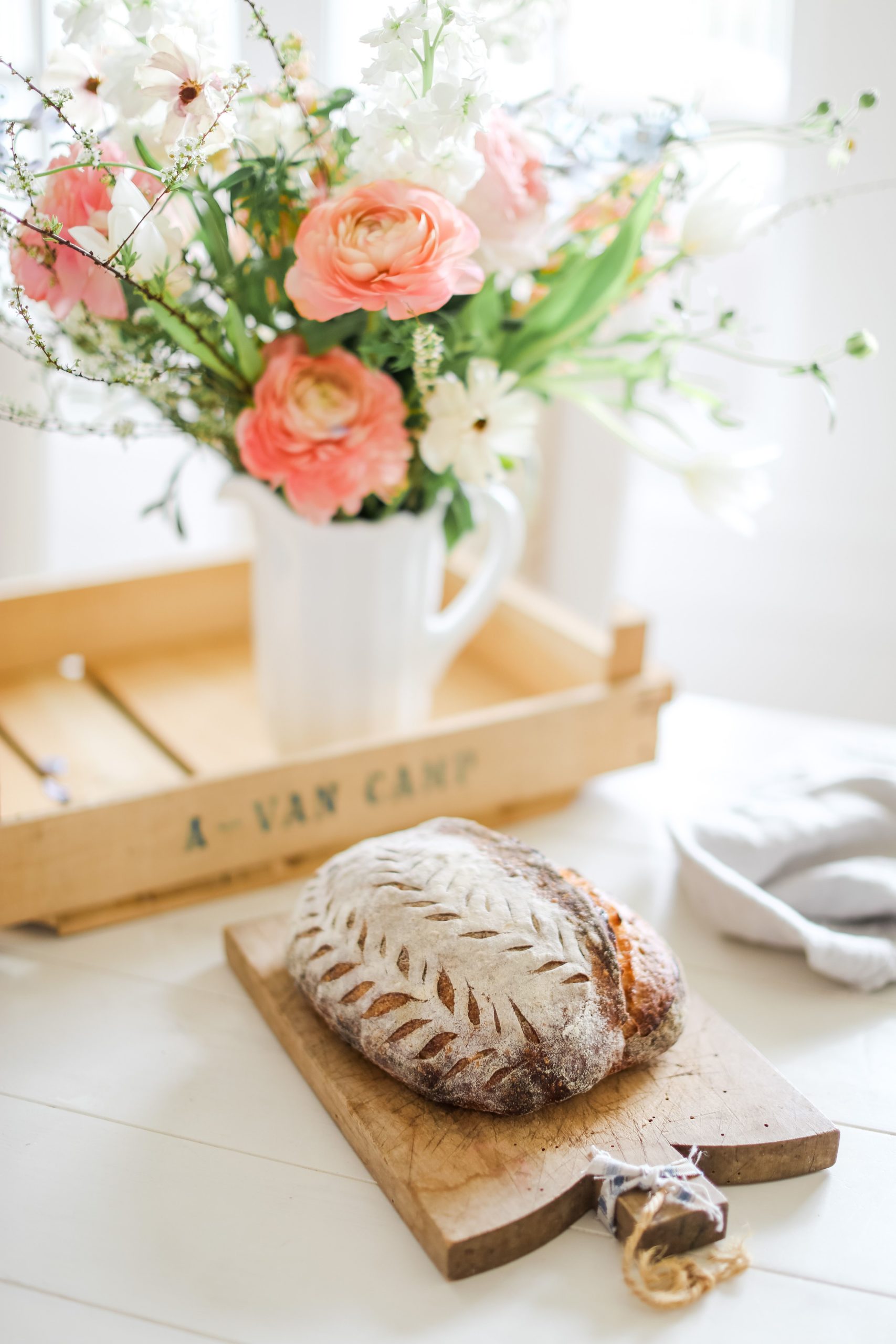
SHOP THE POST
You may have created your own starter, have one that has been passed down to you from a friend OR you may be jumping into this whole new journey with an open mind and a willingness to learn! No matter the reason, we have got you covered! My goal is to guide you through, how to build a starter, care for it, feed it and love it as your own! All you need is a little time, patience, and some flour and water. If you’re looking to step up your sourdough game with Tori and learn how to turn this starter into incredible bread, click here for our Sourdough 101 Series and use code FRAICHEBAKES at checkout to get $75 off of the course!
What You Need to Build a Starter:
- Bread flour (If you are in Canada, all-purpose flour will work)
- Rye flour (or a whole grain flour – whole wheat spelt, einkorn, kamut, etc.)
- Water
- Kitchen scale (Or use convert to cups calculator here.)
- Jar (I like a Weck Jar as it has a wider mouth, but any jar will do)
- Spoon to stir! (wooden or a rubber spatula)
STEP 1: Build Your Starter
When I start a sourdough starter, I always name it as if it was a pet. This helps us remember that it is ALIVE, and it needs to be fed … like any living thing!
All you need to do is feed your little sourdough pet flour and water, and then discard some and feed some more in order to help it grow. Don’t overthink it. Just like any living thing, your sourdough starter needs care and consistency. You may see it develop in 3 to 4 days, or it could take 10+ days of consistent feeding to become a healthy, active starter. It will only get stronger as it ages.
How to build a Sourdough Starter:
- Take an empty jar. Put it on the scale and zero out the scale (this is called “tare on the scale.”)
- Add 50 grams of water (¼ cup) to the clean jar.
- Add 50 grams total flour (⅓ cup): 20 grams of rye flour + 30 grams of bread flour
- The whole grain flour is used because it:
- Speeds up the process
- Has a higher enzymatic activity
- Ferments faster
- Has more nourishment, sugar & energy to feed the wild yeast so it multiplies faster
- The whole grain flour is used because it:
- Stir to combine.
- Put on a lid (don’t screw it on or fasten it, the lid should sit loosely on the jar) and let sit at room temperature for 12 hours. This will keep your sourdough starter or ‘pet’ happy and well nourished (you can feed every 24 hours if you prefer, but every 12 hours will speed up the process).
STEP 2: Feed your new Starter
We are going to feed our new pet TWICE a day for the first week (every 8-12 hours). Repeat these steps for every feeding and keep your starter at room temperature – not too cold and not too hot..
How to feed a Sourdough Starter:
- Discard ALL but 10 grams (or 90%) of starter from your jar.
- This does not need to be exact, but you are welcome to use a clean jar and measure 10 grams exactly.
- The leftover starter is now ‘discard’ – store it in a container in your refrigerator. You can use this in discard recipes such as pancakes, waffles, scones and more that are designed for using up discard.
- Place the jar on the scale and zero (tare) your scale.
- Feed the starter – equal parts of flour and water – and stir to combine
- 50 grams water (¼ cup)
- 50 grams flour (⅓ cup): 20 grams of rye flour + 30 grams of bread flour
As you see, we feed our starter a ratio of 1:5:5 = 10 grams starter : 50 grams water : 50 grams flour. There are many ways to feed a starter, we have found this method to work for MANY, MANY people.
Why do I need to discard for a starter?
The thing to note is: ALWAYS feed a SMALL pet. Think of your sourdough starter as a child. When you have 10 grams of sourdough starter, it is like having 10 kids. In order to feed these kids and keep them happy and well nourished, they need 50 grams of water and 50 grams of flour once or twice a day.
BUT, these kids multiply quickly. About 12 hours after a feeding, the 10 kids become 110!!! Yes, all that flour water you fed it, magically becomes MORE kids!! Yikes, that is a lot of kids to feed.
So, that is precisely why we ask you to DISCARD the majority of your starter at each feeding. You cannot expect 110 kids to be well fed and nourished on the same amount of food 10 kids would be. So, send 100 of those kids packing (discard in the fridge or compost), and just keep the original 10 to feed. Make sense? I hope so. This can seem complicated, but I promise, after just a few feedings, it will start to make sense.
You can use your discard in recipes specifically designed for discard (or you can compost it… but why waste?). King Arthur Flour has some great recipes (click here).
How to know when your new starter is active:
- Yeasty smell
- Bubbles
- Lots of activity – you can SEE it and HEAR it. It will usually double its size in 4 to 6 hours (then falls – you may miss the process if you aren’t watching closely!).
- It will float in water: try the float test by placing a small amount of starter in a glass filled with water: if it floats it is an indication that it is active.
STEP 3: Maintain Your Starter
After about a week, and once you see your sourdough starter active, bubbly, and happy, you can transition to feeding it 50 grams of water and 50 grams of bread flour (no rye flour necessary anymore). At this point, it doesn’t need to be fed twice a day, and instead you can feed it every 24-36 hours, assuming it is stored on the counter (every 24 hours is ideal if you want a very happy and active starter.)
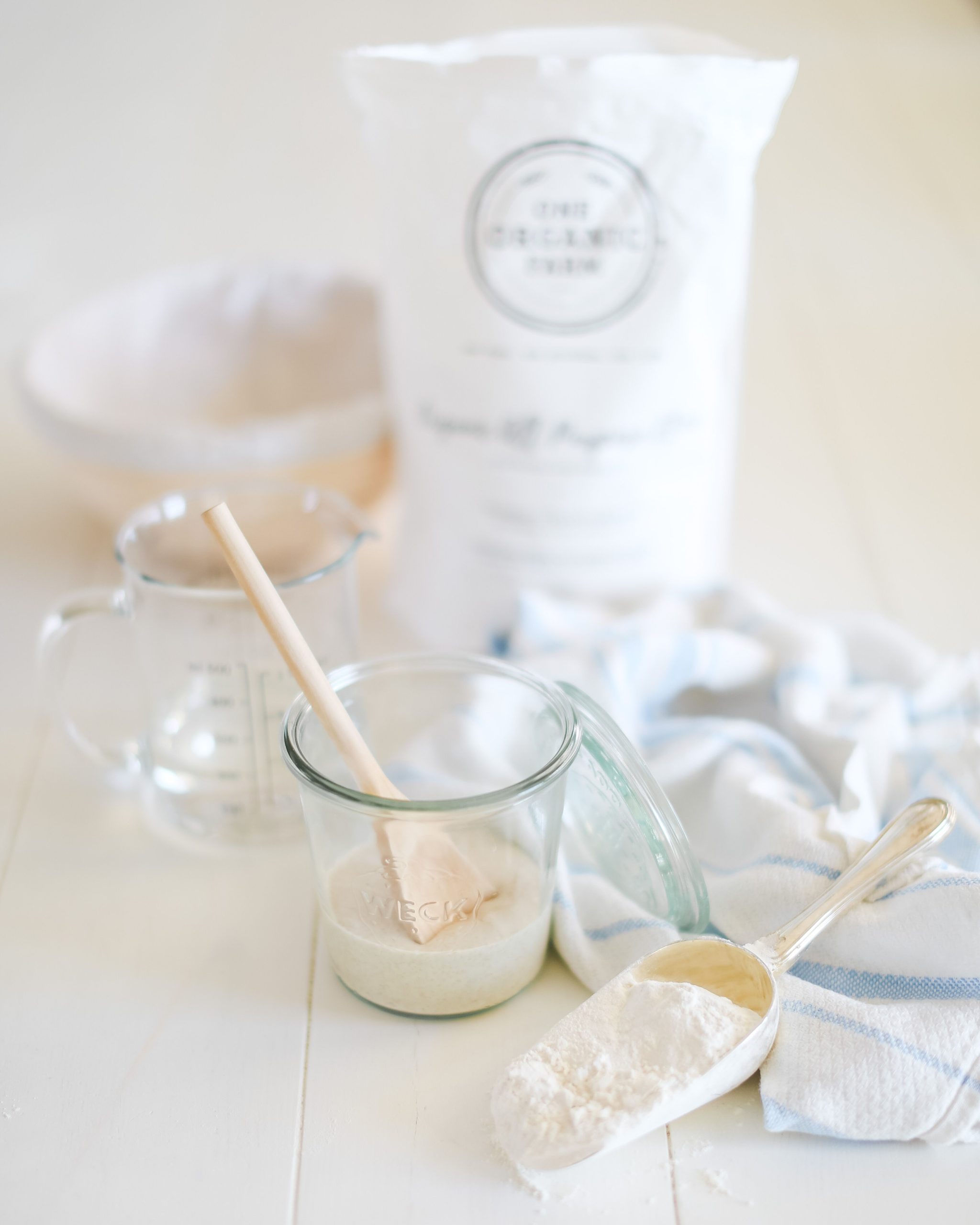
How To Refrigerate Your Starter
If you are planning on baking less often, such as bi-weekly, monthly, or less, the FRIDGE is your friend. Feed your PET, let it get active for 3 to 4 hours, seal the lid and place in the refrigerator. You will need to repeat the above “FEED IT” process about once a week. This helps make sourdough “fit” into your life… it’s a little less needy this way!
How To Refresh Your Starter
If you have been FRIDGING your sourdough starter, it will need to be REFRESHED at least twice prior to baking. Think of it as having just come out of hibernation. If you plan to bake on SATURDAY, remove your sourdough pet from the fridge on THURSDAY morning. Give it a feeding (50 g water + 50 g flour + 10 g sourdough starter) and leave it at room temperature. Repeat on FRIDAY morning. You will start the bread making process on Friday night (to be continued!).
If you are interested in mastering the art of making sourdough bread (and creating beautiful loaves like the one pictured below) don’t forget to use the code FRAICHEBAKES for the Sourdough 101 Series courses here to get $75 off.

FAQ’s about Making a Starter:
Q: Will using a metal spoon to stir my starter kill or damage the starter?
A: No, it won’t damage the starter. A small wooden or bamboo spoon will work well, as will a small rubber spatula (easier to clean)
Q: If I only have all-purpose flour will that work?
A: Yes unbleached all-purpose flour will work, it may just take longer to get to the active stage!
Q: What type of container is best to use?
A: Weck jars are our favourite, but you can use any clean jar or container. One with a wider mouth or opening on it is best as it makes it easier to stir.
Q: Do I need a specific recipe for using the discard or can I use it in any recipe?
A: You will want to find a recipe that is specific to using discard as it already has the flour and water mixed together.
Q: What are some signs that my starter has gone bad?
A: If mould has grown (unlikely). It is hard to ‘spoil’ your starter!
PS: (Tori here) My aunt Mary has an AMAZING gluten free blog called A Couple of Celiacs and teaches you how to make delicious gluten free sourdough if you’re looking for a gluten-free bread. I’ve had it… it’s incredible!

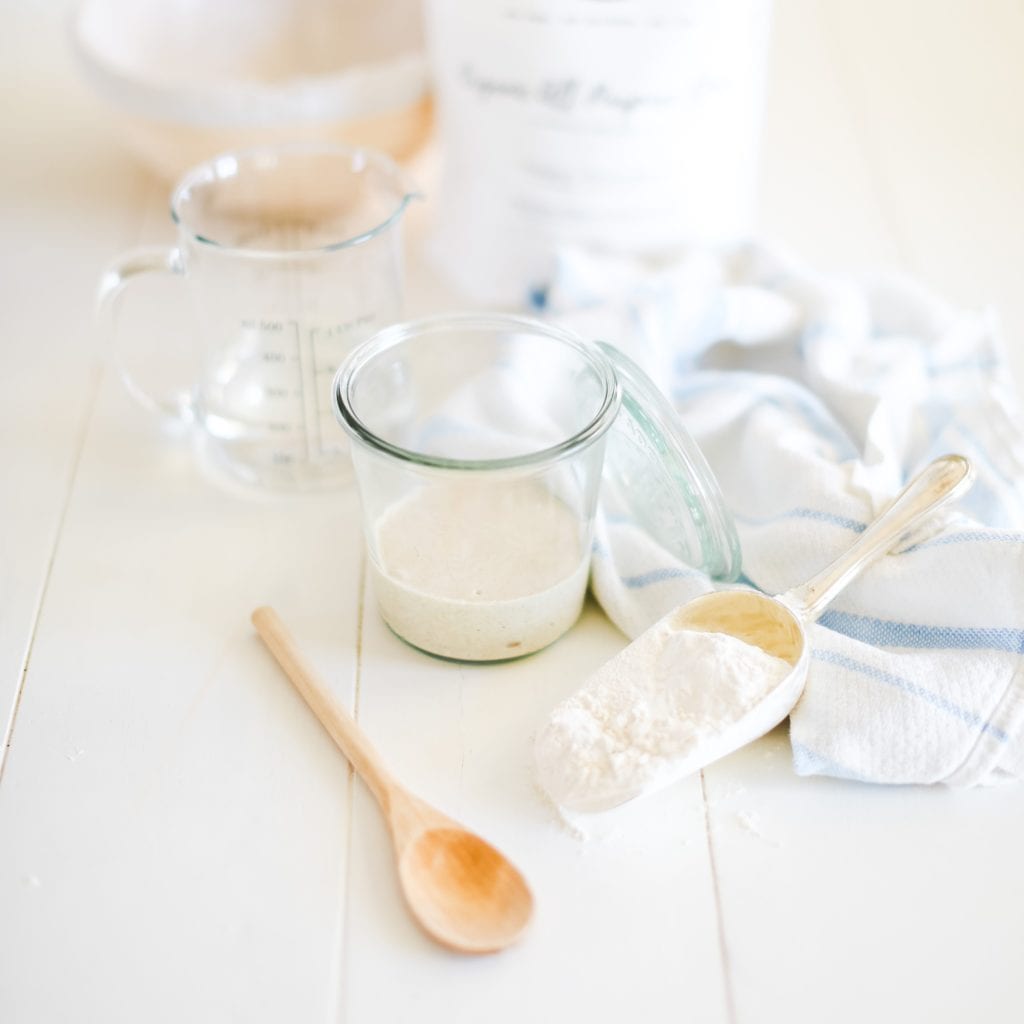

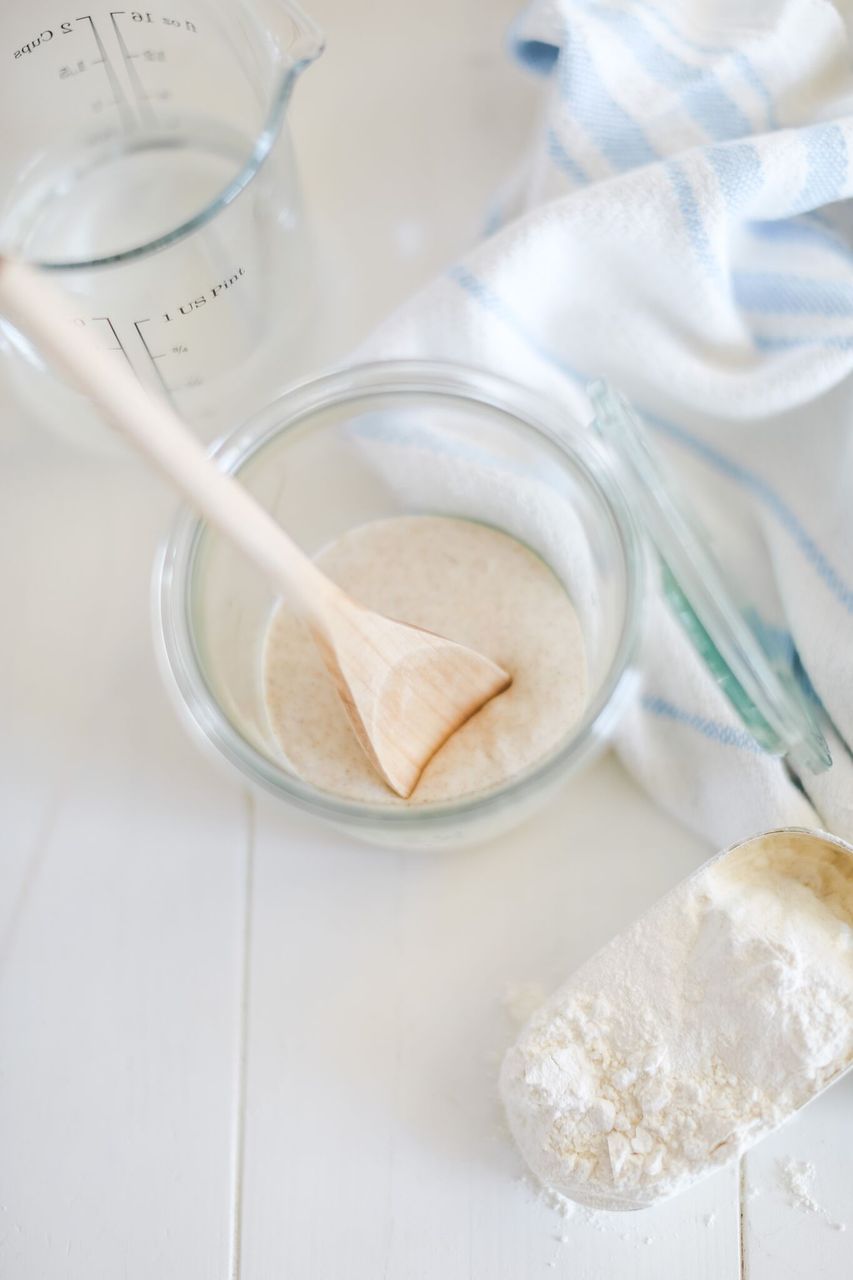
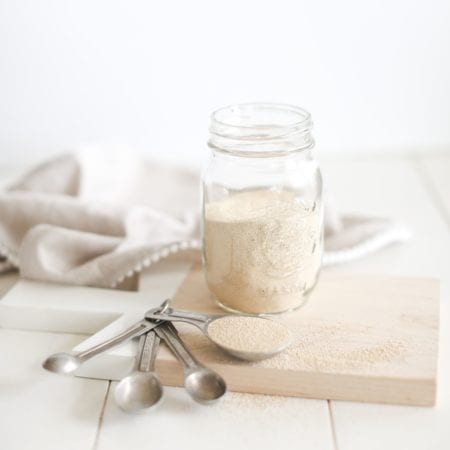
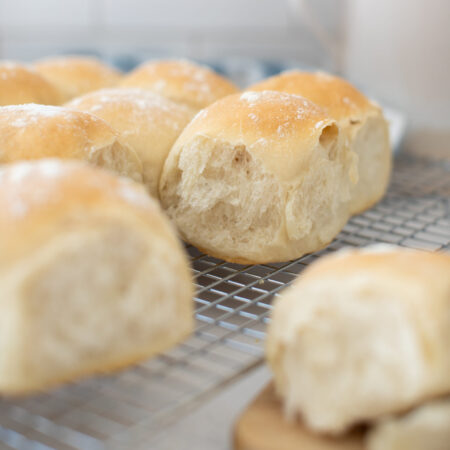
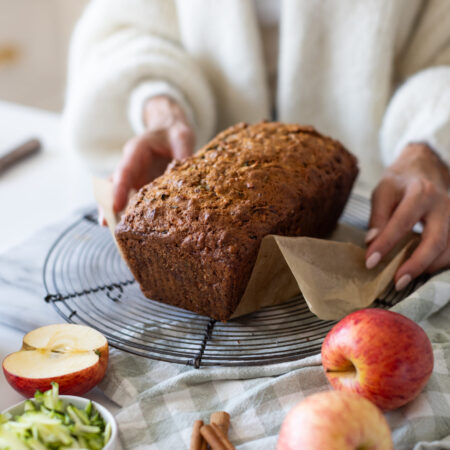

Hi Tory,
So I have my starter started… and will feed in 12 hours… so even for the first feed I discard 90%? I get feeding the kids thing, haha, boy do I, but I was wondering if I do this if it’s only 12 hrs old.
Thanks!!!
Darlene
oops, I couldn’t delete the message above!! I see after reading the directions again that I do discard. Wow, I didn’t think yeast could be created so fast…!
Sorry about that! have good day!
Darlene
No worries! I started mine late Thursday night and was still wondering this too. I didn’t discard after day 1 because it seemed odd, too soon. So I’m glad this was clarified :).
Tori, may I ask, how long can you keep and pile together your discard until it becomes it’s own thing? (It’s if it’s just 500 hungry children, will they freak out and go bad- lol).
Hi Darlene, it’s a great question. I haven’t found any good information on how long you can keep it for to be honest. As it does have some activity it doesn’t play by the same typical rules of food safety. I’ll continue to look into it. I have one from a few weeks ago and am still using it!
I have read that the all purpose flour has to be unbleached but all I have is regular all purpose (and whole wheat). Will it still work if I don’t use unbleached? Thanks!
yes that should be ok!
I started Floyd 5 days ago. I am following a different recipe. 50g starter. 100g water and 100g flour. Using all purpose as that’s all I have right now. It’s definitely starting to bubble and get active. But when it’s time to feed him he seems a little watery. Is there something I’m doing wrong? Also can I start to reduce the amount of flour and water and starter 100g seems like such a waste. And can I start using different flour or does it need to remain consistent? Thanks
Hi Elana,
If you are already using all purpose flour I would just continue (unbleached is best). I use a smaller ratio and I think that 50 g of starter is a lot to keep feeding: I use around 10 or so grams and feed it 50 g of water and 50 g of flour you could just use a smaller amount of starter and feed it less as indicated in the blog post and that would help! Sorry for the late reply here! And I understand it’s common for the starter to separate a bit not sure if that’s what you’re referring to?
Where can you find Weck jars in Canada ? I’ve been on the hunt for the perfect wide mouth jar for months. These look great!
I get mine from Lakehouse in Kelowna!
I found mine in our Peavey Mart hardware store. 🙂
Hi Tori!
On a previous Insta story I think you’d mentioned that you thought maybe having 2 starters in your home meant that they were competing for the yeast in the air and that this was possibly affecting the health of the starters. Have you confirmed if this is true? I already have a healthy, active starter but wanted to try making one with different flour to see the difference and I don’t want to do that if there isn’t enough yeast for both of them to be healthy.
Thanks!
Hi! There shouldn’t be competition for yeast as far as I know!
Tori this was a fantastic article. Thank you so much! I have been watching your posts over the last few weeks talking about this, and I was so lost as to what was going on. This whole concept was new to me until you started to talk about it. Thursday night I decided to watch some YouTube videos and learn what you and Jill we’re talking about. Haha. I decided to make/try my own. Super unsure I was doing it right, I then was gifted this article. It was perfectly written and answered my questions I still had. Thank you so much. Your recipes never fail.
Can’t wait to see what other articles you do around this.
You’re a Rockstar!
Huge fan from N.B 🙂 xox
So happy to hear you found this helpful Summer! Thank you so much for following along!
Want to order a banneton for my dutch oven. How do know what size I need? Do I order the same dimensions of dutch oven or smaller?
Hi Anita, yes it will need to fit in your dutch oven – I would buy a bit smaller!
Do you have a good recipe to make sourdough bread once the starter is ready?
I am working on one!
Hi, Tori,
Is there a difference the starter will have if I use dark rye flour vs. light rye flour?
Thanks for posting this recipe with great instructions! Hoping to go for it soon! 🙂
Hi Monica! I don’t believe so but I will ask Shannon from Sourdough Schoolhouse!
Did you happen to find the answer to this? I’m trying with dark rye, hoping that will work!
Hi Lisa!! Yes sorry I just found out that it doesn’t matter which you use! Happy baking!
you were giftted a beautiful spurdough pan to bake in what was that called and where do you purchase it?
Hi Amanda! It is the Challenger pan – they sent it to me, but I know you can purchase it online! I also have a red Emile Henry one that is lovely too (it is lighter and a bit smaller). I hope that helps!
Hi, I have been following these instructions for about 7 days now. I forgot to feed my starter last night!! Ugh…can I just carry on feeding it today as normal or is it going to be done now?
Sorry for the delay Jen! Yes just carry on it should be fine!
First time making this. Once I discard some of the starter, can I use the same jar or should use a new clean jar. If I can use the same jar do I have to wash it? Then add the new starter. Hope this makes sense. 😱
Hi Betty, great question! You can use the same jar and you don’t need to wash it (unless you want to!).
Hey Tori! After the 1 week mark when feeding at 24-36 hours begins, do we still discard?
Thanks!!
Hi Sara! Yes you always discard when feeding the starter, great question!
Hi Tori, I am on day 7 and there is activity, bubbles and growth. My question is do I still discard 90% of the starter or do I keep it and just keep feeding it? Are you supposed to permanently discard 90% of the starter for as long as you want to have starter?
Ignore my question. I didn’t notice that question was already asked above.
Hi Tori
When I tried to reactivate my starter after taking it out of the fridge I used just unbleached all purpose flour and water to feed it and nothing happened after 2 days. Was I supposed to use all purpose plus rye flour instead? Thanks!
Hi Nancy, you should have been fine with that flour.I’ve been told that unbleached flour works best but this should work too? How long was it in the fridge for without being fed? Was it active before you put it in there (assuming the answer is yes here!).
Take care, Tori
Hi Tori,
I’m trying to make my own starter and had a quick question. Once the starter is active we continue to step three and feed it, did I read this correctly? And then How long do we do this for?
Hope to hear from you soon!
Hi Josie sorry I just saw your note! Yes, once it is active you can either keep it on the counter and feed it every day OR keep it in the fridge and feed it once a week. The only thing is that you will need to feed it and increase the activity before using it if you keep it in the fridge. I hope this helps!
Perfect! Thanks so much Tori!!
Sorry Tori one last question; when feeding the active starter do we still discard?
Thank you!
Hi Tori – I have been working on this sourdough starter for a couple weeks now. I originally started it how you have 50g water, 20g rye and 30g all purpose. Then i switched to all – allpurpose and now have switched back to the original but I am getting no rise at all. Wondering how long it took for your starter to start working. Mine has a sour smell but no yeasty action. Thank you!!
Hi Shelley I know we sent an email but please let me know if you have any other questions!
Hi Tori,
I just moved from a week of feeding it partial whole wheat partial AP. It’s all bubbly and happy but it seems as soon as I switch to just AP, it’s not as bubbbly and definitely not growing as craZy as it was with the whole wheat after 12 hrs…. Will I see more growth in the next 12? (The instructions above says to feed it every 24)
Thanks
Hi Vanessa, yes you should feed it every 24 hours once it is active if it is on the counter, or once a week if it is in the fridge. Did you use unbleached AP flour? That tends to work better but you should still have an active starter after feeding it. The advice given to me was to keep on feeding it and it should bounce back.
If I leave the starter in the refrigerator for two weeks(with no feeding) when I’m on vacation, will it be ok?
Hi Judy, it needs to be fed more frequently typically (once a week) – can you get someone to ‘babysit’ it for you?